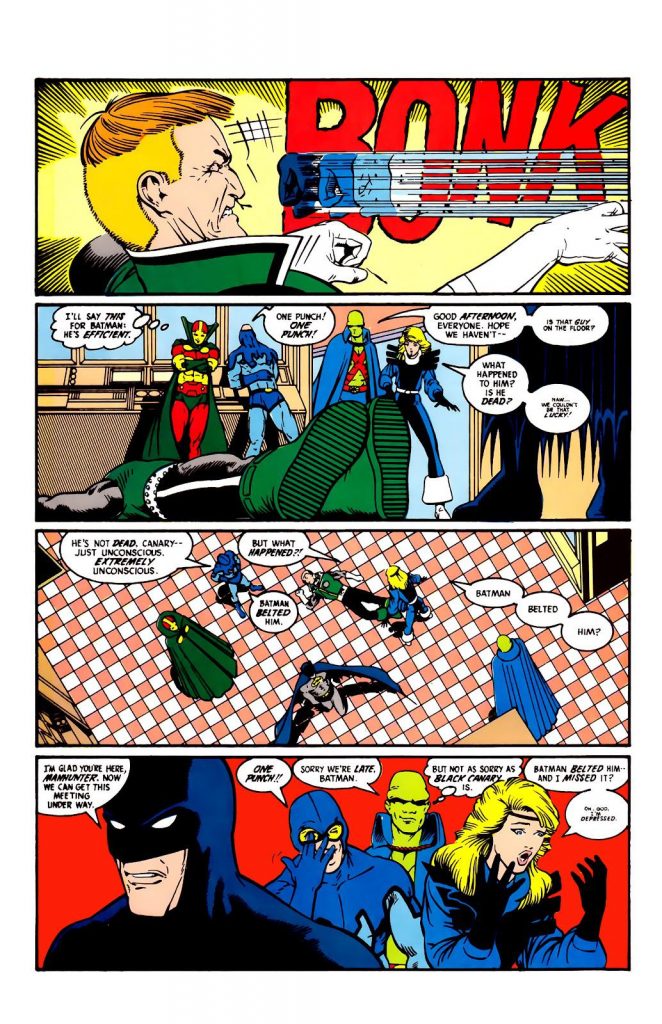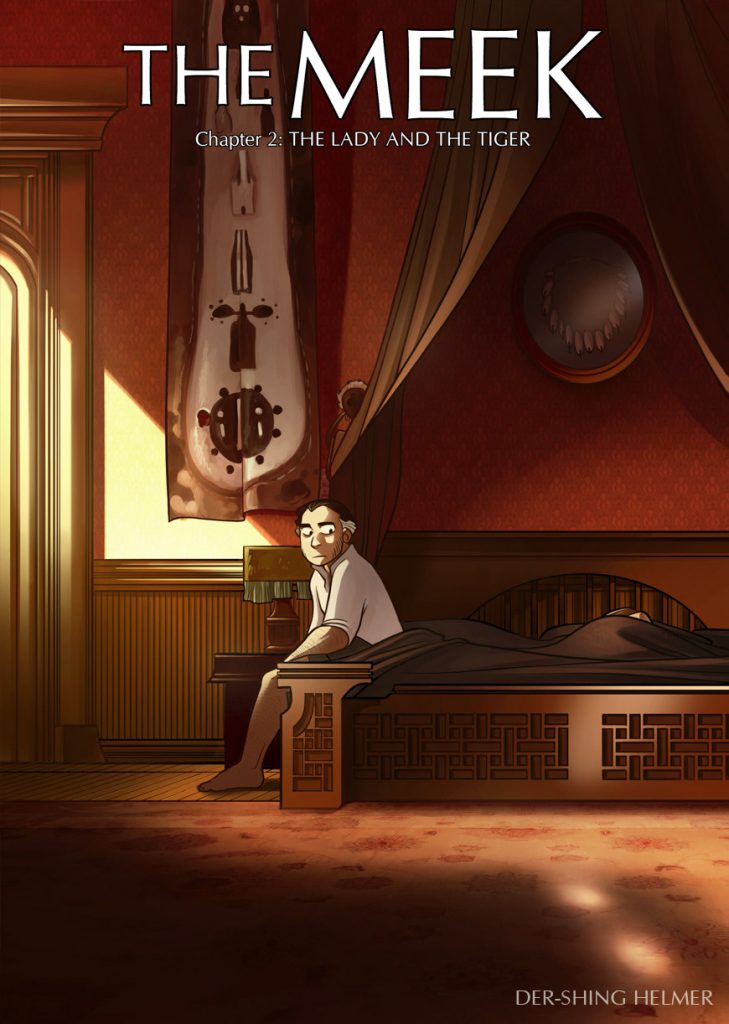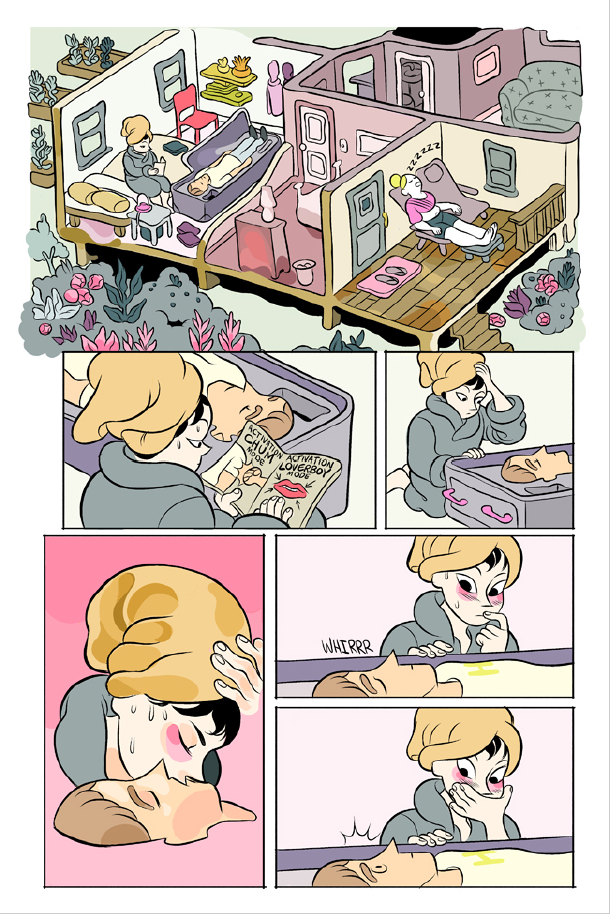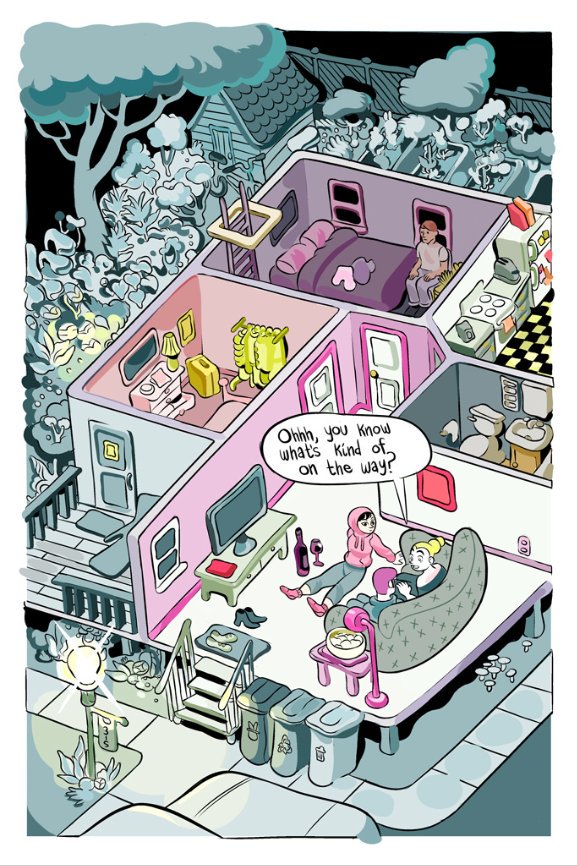The Comics That Made Them with Ngozi Ukazu
The comics you read and the comic experiences you have early on in your life often form the building blocks of your relationship with the medium. Obviously what you’ll enjoy expands from there, but for readers, those earliest experiences can be enormously influential on you going forward. It’s the same for our favorite creators. Some of those foundational elements can define the interests or views of writers or artists in the future. This interview series is all about those, as I chat with creators about five of the biggest influences and inspirations from the time before (or while) they were working in comics. This is The Comics That Made Them.
There’s a shortlist of creators whose work just seems to perfectly fit my brain. Creators who are good at everything, but are particularly effective at character work and always seem to remember that these funny books should be, you know, funny.
Cartoonist Ngozi Ukazu is one of the folks at the top of that list. The first time I read Check, Please! – Ukazu’s exceptional webcomic series turned First Second graphic novels – was love from the first page. This comic follows Eric “Bitty” Bittle, a figure skater, vlogger, and baker, on his journey of discovery and life as a college hockey player. Bitty spends the series figuring out his identity as a hockey player and as a gay man, while also coming to terms with the fact that checking is a thing in hockey? It’s all that and a whole lot more, and every single page is an absolute delight. Ukazu delivers a series that is emotional, involving, and genuinely hilarious. I’m a big fan.
So, when I was thinking of who to talk with next for my recurring interview series, The Comics That Made Them, I thought who better than Ukazu, someone whose work speaks to me on such a significant level. Given how much I enjoy chatting with her and our aforementioned overlap in sensibilities, I figured Ukazu’s list of five works that impacted her would be a) a fun mix and b) a likely path to discovering some comics I’d love that I hadn’t read before. And you know what? I was right! This chat proved to be a very enjoyable one, as we discussed a quintet of comics that ranged from DC Comics classics and fan art to early loves and Ignatz Award winners. It offers a lot of insight into one of the best (and funniest) cartoonists in comics, and an excellent reading list for anyone who has missed any of these comics before now.
You can read it below. It’s been edited for length and clarity, and it’s open for non-subscribers. If you enjoy our chat, make sure to read Check, Please!, and maybe consider subscribing to SKTCHD for more conversations and features like this.
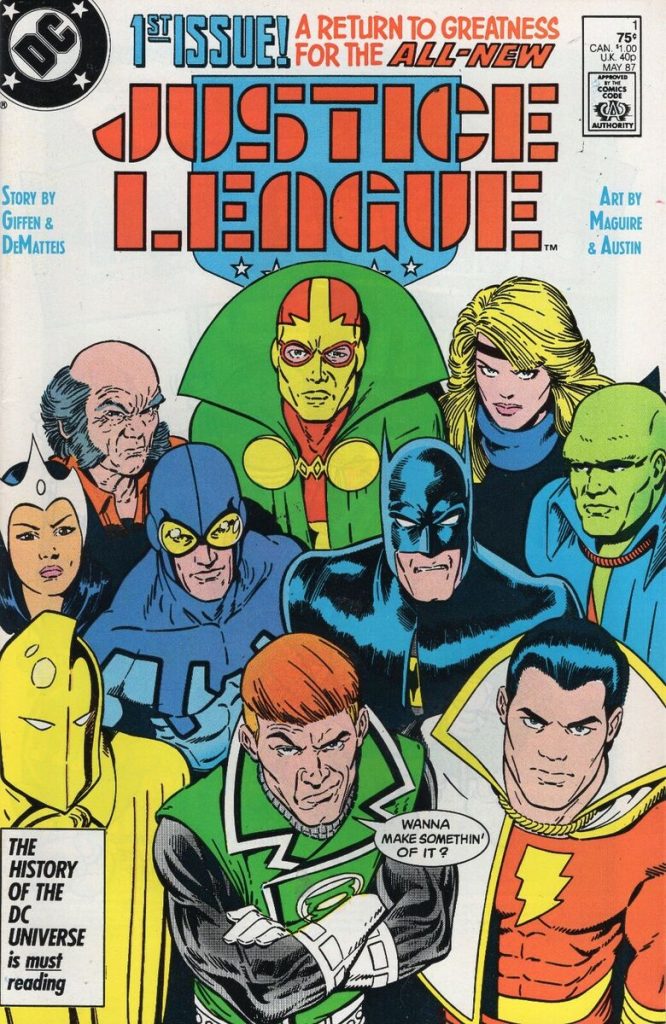
Up first we have J.M. DeMatteis, Keith Giffen, and Kevin Maguire’s Justice League International. The BWA HA HA era of the Justice League, with a team featuring both heavy hitters and Guy Gardner. It’s beloved amongst a certain set. This is actually the first comic not made by you that I think of when I think of you because…I think it was at 2021’s Emerald City Comic Con where I was talking to you, and I think you had just gotten a commission or something from Kevin Maguire. What did you get?
Ngozi Ukazu: I got Ted Kord.
We were just coming out of the pandemic. I mean, it was still deep in it because it was 2021, but it was the first time I had been to a comic book convention since 2019, and I was so thrilled to see Kevin Maguire. I just was chatting with him. I wanted to buy a piece from him, but he had sold all my favorite pieces. He said, “Oh yeah, someone just took a Ted Kord Blue Beetle.” And I was like, “Ah, drat.” (David laughs)
But then, thank goodness, this man (who bought the Blue Beetle piece) had a clear bag. I saw him walking by my table. I was in mid-conversation with someone else. I rushed up to this man and was just like, “haha, LOL. Can I buy that off of you?” (laughs) And this guy was with his other pals…they were Gen Xers maybe, and we were just joking. They were like, “Wow, she really wants that Ted Kord.” And I was like, “Yeah, he is my favorite superhero.”
And his buddy started pressuring him. He was like, “Dude, I think she wants this more than you do.” And I was like, “I do. No pressure, but I do.” So, the guy walks away, and then he comes back maybe an hour later, and he was like, “I’ll sell this to you for the same price. I bought it from Kevin Maguire. You clearly want this more than I do.” And I was like, “Sir, thank you so much.” So we made that exchange. He actually picked up a few Check, Please! books as well, which was so kind of him. And then the next day, he came back and asked me for a commission of Ted Kord.
WHOA!
Ngozi: So, it was a full circle moment. My first moment of creative connection after the pandemic. It was awesome. And I gave him a drawing of Ted Kord. Give a penny, take a penny. Give a Kord, take a Kord.
I know you were really into the Justice League animated series when you were growing up. Was Justice League International one of your earliest comic reads, or was it just one that happened to hit you in the right place at the right time?
Ngozi: I think what happened was I was watching Justice League Unlimited, and that’s what got me deeper into DC. I had watched all of Batman: The Animated Series and The Adventures of Superman, and then there were certain characters that kept popping up (in Justice League Unlimited) like those Charlton Comics characters.
The Question was in Justice League Unlimited, and I was like, “Who’s this guy? All the people on LiveJournal are writing fan fiction about The Question and all these other characters.” And that’s when I started hearing about Blue Beetle and Booster Gold. Booster Gold was also on Justice League Unlimited. That’s when I was like, “Oh, these characters, people keep talking about this comic they were in. They keep posting all these things.” And that’s how I got into the JLI comics.
You once described this comic as “a 90s sitcom masquerading as a comic.”
Ngozi: Yes.
I know you’re a big fan of the art form of the sitcom. Do you think that’s one of the reasons you love this comic so much?
Ngozi: Yeah. That’s it. (laughs) I grew up watching Frasier, The Simpsons, lots of reruns of Sanford and Son. I love sitcoms. I love banter. I love characters that just fit into these tropes. As soon as I started seeing all those screencaps on LiveJournal…there was a LiveJournal Community called Scans Daily.
I think that still exists.
Ngozi: It still exists. Nothing on LiveJournal is in its heyday, but Scans Daily, that was the hookup. And when they were posting all these scans of Justice League International, I was like, “Whoa.” It was basically Netflix, man. I was just reading all these two-to-five-page scans; however, many was the limit. And I was just like, “This is so funny. This is so stupid. There are so many shenanigans. There is so much tomfoolery. There’s so much hijinks. So good.” (David laughs)
You’ve always been naturally drawn to stories with comedic elements in general though, right? It’s not just sitcoms and it’s not just JLI. Even your own comic, Check, Please!, is a very funny one with sitcom elements. Is that a common draw for you? If something has those hijinks, you just can’t resist it?
Ngozi: Yeah. If something’s not funny, it’s very hard for me to get into it. I really need a comedic element in most things I consume. Right now, I’m reading a webcomic called Matchmaker (by Cam Marshall) printed by Silver Sprocket. And it looks cute. It looks great. But what got me in was like, “Oh my God, I haven’t read a straight up funny webcomic, almost a gag comic strip, in a minute. It’s been a while.” So, for me, humor just has this…it’s this extra language that really draws me in. It lets me know what the person is thinking, what the artist is kind of trying to get to, as opposed to melodramatics or horror as the vehicle for some people. For me, it’s humor.
It seems like sometimes humor is not something a lot of comic readers look for. Especially in superhero comics, people can be like, “Oh, this isn’t a serious comic. This is this joke comic.” It devalues it. But it’s funny to think about because the comic form is so perfect for comedy. In JLI, there’s the one punch scene.
Ngozi: ONE PUNCH!
ONE PUNCH!!!
The first panel is Guy Gardner getting punched in the face by Batman. And then the next one is everyone laughing hysterically, including your guy Ted Kord saying, “one punch!” over and over. It’s so perfect. I think that funny comics are underrated. I know that that might not be that hot of a take or maybe humor being devalued is not a universal view, but it feels like that sometimes.
Ngozi: Yeah, I mean…they are. I feel people are very self-conscious about consuming comics and cartoons, even to this day. They’re seen as childish. They’re seen as lesser art. I don’t care. I really don’t. I do a lot of standup comedy, which is the lowest slash highest form of theater. It’s vaudeville.
It’s funny that you say comics are a great vehicle for comedy. I mean the etymology is right there. (laughs) It’s right there. The comic strip, it was intended for humor and entertainment, that type of nonsensical titillation. And that’s what I love. My best friend and co-author, Madeline Rupert, started up her long running webcomic Sakana recently. I was checking out a strip and I was like, “Every single panel of this is funny, and that’s why we’re friends.” That’s why I fell in love with her art. She can draw circles around most people and she’s funny.
I think another interesting thing is that memes are so prevalent nowadays. They’re ubiquitous. They’re everywhere. And memes are just comics with mostly real pictures. Words plus picture…funny intent…that’s comics. More people like funny comics than they let up.
It is funny to see how many comic panels become memes, like there’s this one of Sauron from the X-Men who doesn’t want to cure cancer, he wants to turn people into dinosaurs.
Ngozi: Yeah.
And it just becomes this thing that spreads everywhere. I did this piece on comics and memes, and I talked to the writer of that panel, Elliott Kalan, for it. He’s written TV shows and comics, and he said something along the lines of, “I think more people have read that panel than they’ve read or watched anything else I’ve done.” And that’s just how it works. It is funny, though, the panel sequence is just basically the same structure as a joke. It’s set up and then punchline, quite literally in this case.
But I wanted to ask about Kevin Maguire. You got that piece from him. Was part of the reason you love JLI so much because of his character acting? Because I feel his facial expressions have this comedic element that really seals the deal, which you do really well too. Was that impactful on you?
Ngozi: Yeah, a hundred percent. I feel every artist I like has that x-factor that draws me in. I love Chris Samnee. Chris Samnee is great at action. He’s great at just draftsmanship. But his bread and butter is really composition and using black placement to create compositions. And Kevin Maguire…it’s very rare to have someone who draws in such a relatively realistic style to have characters who are that expressive. Not just in their facial features, but also in what their bodies are doing.
In that scene you mentioned where (laughs) Batman one punch knocks out Guy Gardner, in the background, Ted is holding his stomach, head backwards, laughing. A different comic artist would’ve had people maybe shaking their shoulders or holding their mouths. But it’s a full on gag. Full on vaudeville. And I love that expressiveness.
I love the perfect storm of the dialogue and the expressiveness of the characters there. I just always loved Martian Manhood’s response where he’s just doing his normal thing and is like, “Wait, is that Guy on the floor?” And the lettering is super small because he’s just like, “Wait, what is happening here?”
Ngozi: Exactly.
Last question on the JLI front. You are writing and drawing a Big Barda book. Barda was part of the larger JLI story. Do you think that your journey to that project in some ways started with reading this?
Ngozi: I mean it had to.
Sure, but going in, was Barda a character you had an affinity for? So, when you talked to DC you’re just, “Yeah, this is a good fit.”
Ngozi: It’s funny because Barda has never been my ride or die character. It’s not like I was reading JLI going, “One day, I will illustrate a comic about Barda.” (David laughs)
But it was something where I was pitching to DC, I had a bunch of characters in mind and I was just like, “Barda’s story is so fascinating and we only get glimpses of it.” So, I read JLI, and I watched Justice League Unlimited, and I had all this scattered knowledge about Big Barda. And then it hit me that she really needed to have the rest of her story fleshed out. So, you could say that it all started with JLI, but you had to start somewhere. You had to see these characters and start asking questions about them and, yeah, I did.
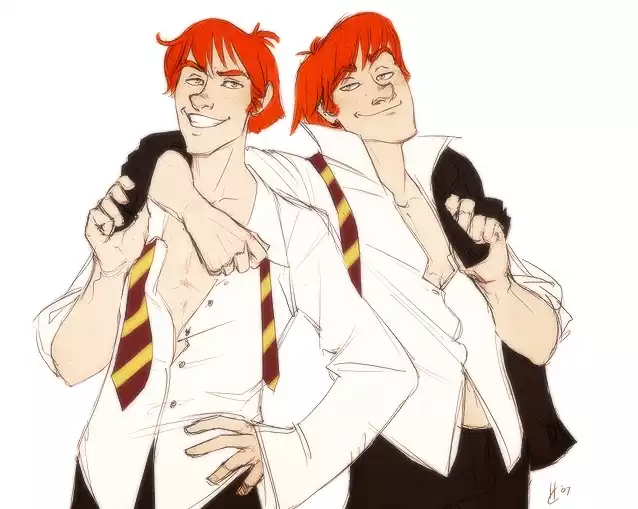
Let’s talk about another item on your list: Makani’s Harry Potter fan art comics.
Ngozi: Yes.
In a lot of ways, this was following the same thing where it’s fleshing out things that were never told. Where Makani is just like, “Okay, I think this is an interesting thing about the Malfoys, but what if I blew that out to the maximum degree and made it really funny.” I never actually heard of these before you had them on your list, but they’re absolutely incredible. What made this one of your picks?
Ngozi: So, straight up, I have never truly been a big Harry Potter fan. It’s never been that thing. I consider myself a fan when I start to write fan fiction. That’s when I’m thinking about the characters in a way that I need to explore their psyche. So, I was never a big Harry Potter fan. But I was always a fan of Makani’s art. Even after they moved on from this initial fandom, they started to draw fan art for Team Fortress 2. They eventually got hired to make official art by Team Fortress 2 and moved on to…I think they were hired by Blizzard to make official comics as well.
I was drawn, again, to the sitcom element of it all. I’m also not a huge fan of the Malfoys as characters. (laughs) I tend to go for the more…I don’t know, I’m not really a bad boy character lover. I don’t like those evil characters. And what sold me on her art…Oh, we should also name the actual name of the artist.
She went by Buttface Makani when I was in high school. (laughs) Buttface Makani. Which one, I’m already in. Two, then she dropped the Buttface which, I know, hashtag branding. But her name is Heather Campbell, and I hope I’m not doxxing her. I don’t know if she wants to be known. You’re known Heather. You’ve affected so many people. Sorry, I want to talk to you. DM me. (laughs)
But it was the same thing. It was just so funny. Expressiveness, humor, amazing draftsmanship. I was in high school just being like, “How can this person paint so well and be so funny and capture the drama and the characterization that I felt was missing from the original stories.” I always wanted a little bit more. She just pulled me in. To this day, I still wish that she kept making fan art for… Oh, she also made fan art for the ABC show, Lost. That drama series?
Yeah.
Ngozi: Oh my gosh, it was amazing. I love that show already but she had all these humorous side takes. Humorous side takes in the form of fan art are the greatest gift you could give to me, and I will dare say you can give to mankind. We’re in dire need of it. It was so good.
One thing that’s great about it too, and just humorous side takes in fan art in general, is it’s all built from the characters. There’s this one strip that is Ron and Hermione, and Hermione just starts kissing Ron. And it turns out that she’s imagining it. And there’s these two panels where Hermione has her tongue out and it says, “Seduce” next to her. (Ngozi laughs) And then Ron is like, “What’s going on with you?” And she’s like, “Oh, I’m fine.”
It’s hilarious but it’s also totally built from character. And I think that’s fun because a lot of these stories are focused on plot and only get into the things that are necessary, rather than what would probably happen if we actually followed the people from Lost or the people from Harry Potter. Makani’s comics tap into a side that’s probably there, but we never get and it’s so fun. I love it.
Ngozi: Yeah. It’s so fun tapping into that extra side. And I think that’s why when I was making Check, Please! I had so many pieces of fan art. It was not fan art. I had so many pieces of art and just extra things that I wanted to throw into the world. I just love the little illustrated asides. It’s just the funnest thing.
Didn’t you have an entire section in the back of one of the volumes that was just about flow…the hair?
Ngozi: Oh yeah. (laughs) So in Check, Please!, there was another comic called Hockey Shit with Ransom and Holster. I just needed extra content. So, it was two characters in Check, Please! who would break the fourth wall, or not really break the fourth wall, they had this mini TV show where they would educate the uneducated (laughs) on hockey culture and hockey slang. So yeah, this is just in my comics DNA. I love a comical aside.
For people who don’t know, flow is basically just gloriously long hair, but it’s also, there’s all these videos for hockey… God, what is it…
Ngozi: It’s the Minnesota High School All Hockey Hair Team. And every year they have a little bit of a…let’s just call it a fashion show.
Basically.
Ngozi: So they can show their flow.
The catwalk is the ice.
Ngozi: The catwalk is the ice. Oh, Anna Wintour, you should take note. (laughs)
I did want to ask about fan art and its place. There are two spectrums. One, people don’t take it seriously and the other spectrum is I’ve seen, I think Faith Erin Hicks, when she posts fan art, she’ll say things like, “This is not meant to be canon” or “This is not meant to be this” because you want to warn people from taking it way too seriously. But I think fan art is fantastic and I love seeing creators embrace that side of them. I love that you have fan art for your own book. But what do you think fan art means? What is its place in comics in your mind?
Ngozi: Fan art. Oh my God.
David, you ask a deep question because we get into the nature of the post consumption process. (laughs) What happens after you read something, after you listen to something, after you watch something. Some people turn to wanting to find out everything and anything about the subject matter that they consumed. Categorizing information. We call that curated fandom. And then you get people who feel so connected to whatever they consumed that they want to explore it in a way that makes sense to them. Explore it in a way in which they see themselves.
And I think those are the two ways of exploring fan art. When you see someone maybe make a pinup of a character or a cool…I’m thinking of… What’s his name? Oh my gosh. Johnson…
Daniel Warren Johnson.
Ngozi: Daniel Warren Johnson, who makes incredible fan art and obviously his own comics. You’re seeing a reinterpretation of a character and maybe exploration of all their powers but then a friend of mine might illustrate a comic about Darth Vader having breakfast or something. (laughs)
So, it’s this tool for…you consume something, you experience it, and you can explore it again. It’s funny…in my metric for what makes art good, seriousness is not included. I don’t even think about it, if something is serious or not. So I know people may not take fan art seriously but then I wonder what they do take seriously. We’re probably speaking two different languages. They don’t seem very fun. (laughs)
I do think these Harry Potter fan art comics are fascinating because in some ways, they’re the most similar to Check, Please! and how you tell stories of the five. Do you feel like seeing these early on opened any doors in your brain about what you could do with comics?
Ngozi: I think looking at Makani’s art, it was what I wanted from a series that I thought was interesting but never really pulled me in. The obvious disclaimer to whoever’s reading this, J.K. Rowling sucks, but I felt like Harry Potter was interesting, and that I wanted it to do two things. I wish it were funnier and the characters were more interesting, and I wish that we had spent more time learning about the actual magic system.
I couldn’t get the second thing from the fan art that I was looking at on LiveJournal, but the first thing was entirely what Makani provided. And when I was making my own comics, I was like, “I want to make sure that we see these characters again and again, just in sitcom situations where they’re going to react organically and naturally based off who they are to a variety of humorous situations.” So fan art was a great tool for that. When it comes to Check, Please!, my own art, the extra art was really fun for that.
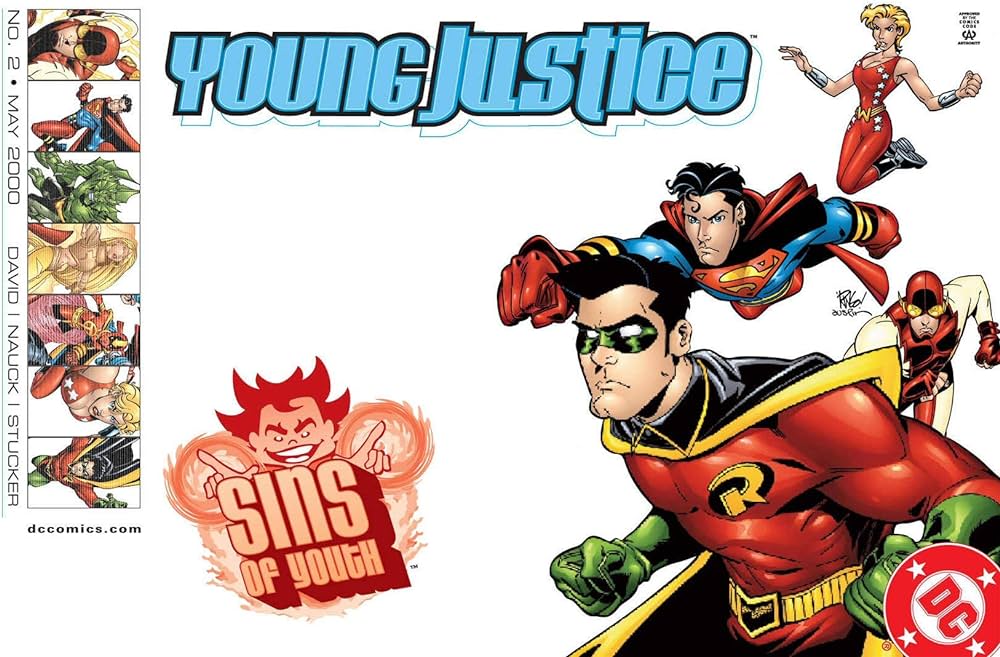
Next up is Young Justice: Sins of Youth by Peter David and Todd Nauck, which I read when I was a kid, and I don’t think I’ve read since. It’s the story of Klarion the Witch Boy flipping everyone’s ages upside down. So, the Young Justice team becomes the adults while the adult heroes become children. Did you read this around the same time as JLI?
Ngozi: I think I read this before. I think this was when I was getting into Justice League and Justice League Unlimited. I have my copy that I got when…I have no idea how old I was. I just remember getting this, and I think it hit me because I just read it and reread it so many times and I drew so much fan art from it. I wasn’t a particularly huge fan of Young Justice. I just read this book so many times. I don’t know why I read it so many times. It was funny.
There was that humorous element of, “Uh-oh Batman’s young and Robin’s old.” (laughs) But there was just something about it. Was this the only comic I had one summer? Maybe that was it. I just read this so many times.
When I was a kid, the first trade paperback I had was this X-Tinction Agenda story from the X-Men. I had literally no idea who half these characters were or what their relationships were. But I read it so many times that if you look at my copy, you’d think it’s been run through a meat grinder basically. There’s something to be said about that early comic you get that you just read and read because you’re discovering comics and you’re finding what you love about it.
Sometimes it’s less about the quality or what’s in it, and it’s more about the fact that there’s something about it that just made you want to immerse yourself in it. Do you feel like that’s what happened with you?
Ngozi: I would say for me it was also this element of, Where’s Waldo? There are maybe a hundred different characters in this single trade. You have the entire Justice Society of America. You have Aquaman and his side world. You have Batman and his side world. You have every single villain. There’s just so much.
So, I think when I was reading through this over and over again, there was that element of, “Who is this? Who is that? (laughs) Well, I didn’t notice this person on the first read, who are they?” I don’t think I knew about the JSA until I read this comic, and I was just like, “Who are these people? Why are there so many of them? I’ve never heard of any of these people.” So that was really fun.
The first comic that me realize I love reading comics was The Transformers #41. It was a Marvel comic from the 1980s. I don’t even remember how I got it, but I love the Transformers and I read it over and over. The thing that I loved the most about it was there was this big scene where Jose Delbo did a drawing of a million Autobots and Decepticons fighting on the moon. And I was like, “How are there so many characters on this page right now? This is blowing my mind.”
Maybe my favorite part about it was that in the back, they had a little diagram that said what every character’s name was. And it was like David Harper’s Wikipedia for The Transformers. It blew my mind. I totally see what you’re saying there. Sometimes when it lays that stuff out there and makes you want to ask questions, there’s something really powerful to that.
Ngozi: Yeah, I like just being thrown in. I had no idea who most of the characters were but discovering who they were was half the fun.
So good.
So, there wasn’t really any significant creative things. It was more just about how many times you read it.
Ngozi: Yeah. I read it a lot. I really liked DC Comics. You watch the cartoons and you’re like, “Oh wow, there’s just seven characters in DC.” (laughs) And then you open the book like this and you’re like, “Wait a minute, there’s maybe nine million characters.” And it was a nice little gateway to realizing comics are so infinitely complicated, and that can be a fun thing.
Did you have a natural lean towards DC because growing up?
Ngozi: I’ve always had a natural lean towards DC. It’s so interesting to me. To this day, I still can’t really sink my teeth into X-Men. I’m sure people are reading this and groaning. I’ve never been a huge Avengers person. There’s just something about the Justice League and the foundational knowledge I got from the Batman and Superman series that just…I don’t know, DC’s just a little bit more fun to work with. Can’t explain it.
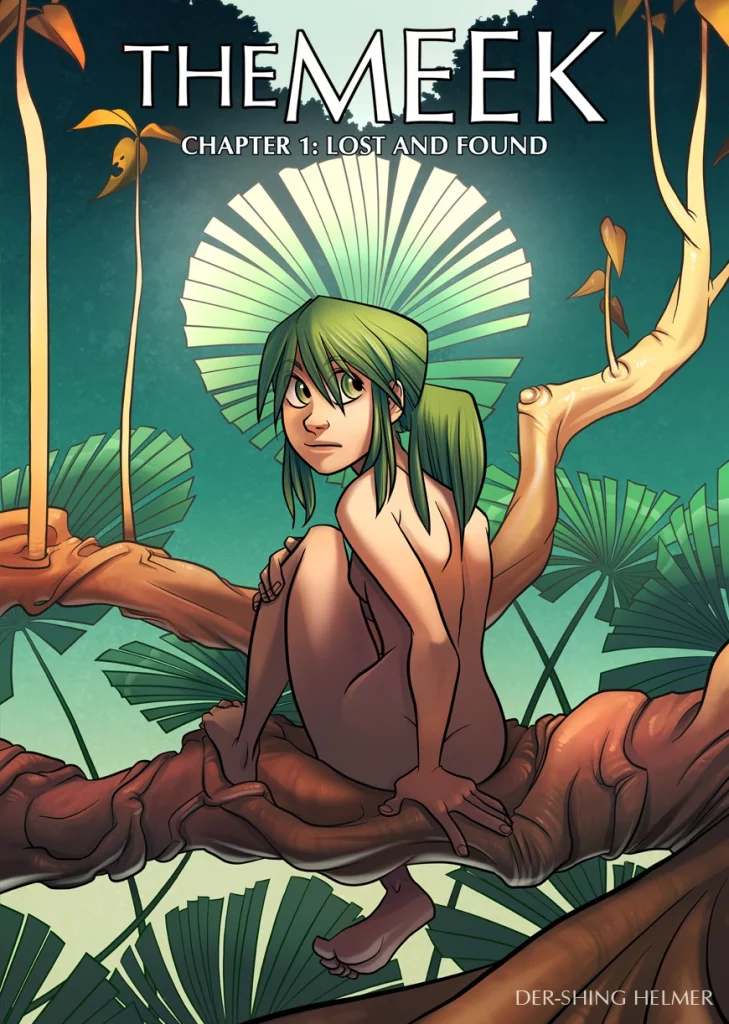
Up next, we have The Meek. It is an Ignatz award-winning web comic from cartoonist Der-Shing Helmer that started in 2009. It’s about Angora, an inexperienced young girl who has been sent on a quest to save the world, per the about section of The Meek’s website. I have to say, when I was prepping for this yesterday, I tried reading as much from your list as I possibly could. That was a trap with The Meek because webcomics, when they get you, you just keep pressing that button to keep going and going. Next thing you know, I lost an hour.
The Meek is a great comic. What was it that stood out to you about The Meek?
Ngozi: This was another LiveJournal find. I remember when Der-Shing was posting uncolored pencil sketches of this comic. You’re a teenager. Some kids go out to the skate park. Some kids go to the mall. I went to the webcomic place, which is LiveJournal, and I just kept, like you said, going through the pages. I still think Der-Shing is such a talented draftsperson. She’s amazing. She’s an amazing artist. But when you’re in high school and you see this, your brain just explodes. You’re like, “Oh my God, this is a full world. These are cool character designs. That chick’s naked. Whaaaatt?!?!” (David laughs) You’re super intense. That’s what stood out to me. It’s just a good high school read.
Is LiveJournal the tie that binds the books on this list?
Ngozi: 100%. Man, I grew up on LiveJournal. I don’t know how I discovered Sins of Youth, and Girl Town was more of a Tumblr age story.
But yeah, The Meek was something that I definitely found out about on LiveJournal.
I do think it’s funny how sometimes the mechanics of how we engage with things are the things that drive us down that path. With LiveJournal and Tumblr, they’re different things, but Tumblr in a lot of ways is kind of a continuation of LiveJournal and its vibe, right?
Ngozi: Yeah. It’s kind of the spiritual successor to LiveJournal. Less blogging, more sharing.
Back when Twitter was Twitter, one of my favorite fan comics was Hannah Blumenreich’s Spider-Man comics that she was doing. Those were so fun. And it’s fun how the medium impacts the comic and influences your read. I mean, The Meek is an interesting example because The Meek is done like a regular comic, but it just happened to be posted on there. But at the same time, it also works perfectly because like I said, it sucks you in. That’s the power of the webcomic. If you come in late to it like I did with The Meek, you can just keep going forever, seemingly.
Ngozi: Yeah, you can totally just binge it. It’s that idea, which I’m not applying totally correctly, but it’s, the medium is the message. Webcomics have a different feel than print comics because there’s just more flexibility and there’s no editorial oversight. You can do so much more.
Do you think that reading these comics early on LiveJournal is part of the reason you eventually wanted to do Check, Please! as a webcomic? It’s just that is what you knew?
Ngozi: Yeah, it just seemed like a viable path. When I started Check, Please!, I thought it was just going to be something I did over one summer after graduating. But it turned into this entire thing. And because I had previous knowledge from reading webcomics, I was like, “Oh, I think I know how to do this, this serialized storytelling.”
Were there any specific things from The Meek that you feel influenced you as a storyteller or was it just more about the right story at the right time?
Ngozi: The Meek was aspirational, I think. Yeah, The Meek was aspirational. I wanted to be as good at painting as Der-Shing. To have a full and complicated story. Oh, I guess I wasn’t going for complicated. but there was just something so cool and masterful about The Meek. It was just a one person show, just totally creating this world from nothing.
That’s one of the things that’s amazing about it. I told you before we started recording, when you get to the second chapter, it just completely turns in a different direction. And I can’t speak to how big it gets from there.
I guess in some ways, that’s like Check, Please! too.
Ngozi: Yeah.
You gave us all sides too. You even had the flow show, and I’m all about that.
Ngozi: Yeah. Check, Please! started off pretty small and then as Bitty, the main character, just kept going through each year of schooling, his story grew a little bit more. And on the side, you had Ransom and Holster doing their thing, you had some other side characters going through life. But yeah, it grew as it went.
So, you started Check, Please! in 2013. That was four years after Der-Shing started this. But you were peers. You were operating in the same space. You were both writing and drawing webcomics. You’re both Kickstarting them. Both building an audience. Do you think that that changes how you view this one?
Ngozi: It actually doesn’t. I’ve hung out with Der-Shing plenty of times. We’ve gotten meals. And she’s still such a cool person. But The Meek was The Meek. When I was in high school reading it, I was just like, “This is the coolest project to do.” Yeah, it doesn’t really change it too much.
Your final pick was Casey Nowak’s also Ignatz award-winning, Diana’s Electric Tongue. A ShortBox release and then part of Girl Town, a Top Shelf graphic novel. I had never read it before and I have to say, this is one of the best comics I’ve read in forever.
Ngozi: Yeah.
It is absolutely incredible. Why is this one that stuck with you so much?
Ngozi: As I told Casey last weekend when I saw them at SPX, I still think they’re one of the best writers in comics. There’s this huge gap between what I see as beginning writing in comics when people are maybe coming up with an idea and they’re trying to start scenes where characters enter the room and say, “This is what I want and I have problems and blah, blah, blah.” They’re declaring things.
Casey is at the other end of the spectrum. I’ve read their even more recent stuff like Bodyseed where they really have no interest in explaining to you what’s going on. They trust that you’re smart enough to pick up on context clues. Their writing and dialogue is very specific. I’m doing a formal analysis of it. I’m just focusing on the writing, and you can go into why the art makes it unique and specific and why the coloring makes it unique and specific, why the lettering, et cetera.
But for me, I do think the easiest thing to pick out is just how specific and almost irreverent the dialogue is. These characters, they don’t care if you understand them. They’re fully fleshed out in their own world.
I like how natural it feels and how immersive it is from the start. You just meet characters and it’s not introducing them, they’re just there.
Ngozi: Yeah.
I don’t remember the roommate’s name, but her boyfriend is sitting on the couch in this one scene while Harbor, the robot boyfriend, is charging. Actually, I think he’s just sitting on a chair in her room because there’s all these cool overhead views of their home where it cuts out the roof and everything.
It just feels like you’re getting a look into somebody’s life. There’s something special about that. And there’s something, not to say that it doesn’t go into deeper places, to the fact that you’re just getting this view into someone’s world, quite literally with the overhead views…it just makes it feel so involving in a powerful way.
Ngozi: The two things that I look for in storytelling, which I kind of mentioned earlier, which were the things that I felt were missing from Harry Potter, were one, world building. Yes, Harry Potter has world building, but I need extra specific world building. And then, two, humor. So in the last four examples of the books that affected me, we’re talking a lot about humor. Girl Town is funny but what it has is this almost incomparable world building that is just so specific. The characters, yeah, you are joining the characters as they are in this very specific world, and I love that feeling.
I love that the very first scene is Harbor being brought into the house and there is literally no explanation as to what it is. It’s just, there’s a giant box that’s being lugged in there. And the roommate is like, “Is that what I think it is?” It is the definition of it in media res. You just get thrown into it and you just go for a ride. I have to say though, it is an emotional story. The ending really hit me like a ton of bricks.
Ngozi: Yeah, I think it ends in a powerful way where this main character is just talking about everything that’s happened to them. I like that it’s not really a neat bow tied ending. So that’s really fun.
It’s just a testimony to Casey’s writing. They know how to maybe do a full circle hero’s journey on the emotional themes of a story without necessarily bringing you to the specific plots to tie everything in. And I appreciate that as well. It’s something that I would love to emulate more in my own writing.
Do you think writing first ahead of art?
Ngozi: I think in terms of characters and ideas first, and then I’ve always used art as a tool to get that story out.
That makes sense.
I was very impressed by the cartooning in this book. It’s interesting to see all the little decisions that make it stand out. The humans use mixed case text while Harbor uses uppercase. There’s this one scene where Harbor compliments Diana and she feels happy about his compliment and this pink circle surrounds her because she’s all warm. And that’s one of the funny things about comics…trying to label something strictly as writing or strictly as art is difficult because things like that are art and writing.
Ngozi: That’s the lovely part of comics. I even love how the dialogue in this book and the speech bubbles are so loose. It feels really handwritten. It gives it this organic feel overall to a book about an android. Hey! (David laughs)
These are all books you have a connection to, to some degree. When you read comics, do you take things in and internalize things you like about them and think about how you could use it? Or is it more just about how it makes you feel?
Ngozi: Anything that I consume, I try to critically break down and see how I could learn from it. And with comics, it’s the same. If something strikes me, I ask myself, “Why? How did they achieve this?” I look back through the comics, see what formally this artist is using to evoke such a response for me.
But also, sometimes it’s just about the vibe, man. You’re just reading a story and you’re like, “This makes me feel scared. This makes me feel weird. This makes me feel excited.” And I try not to overthink it too much if this emotion hits me.

